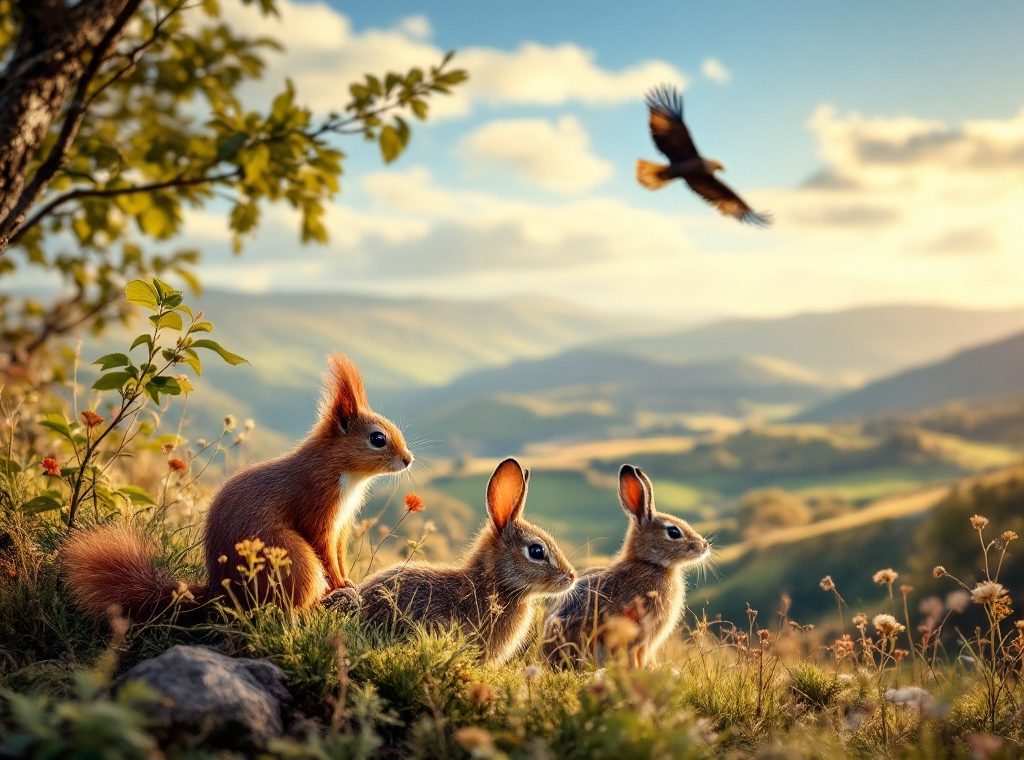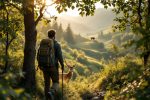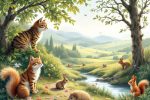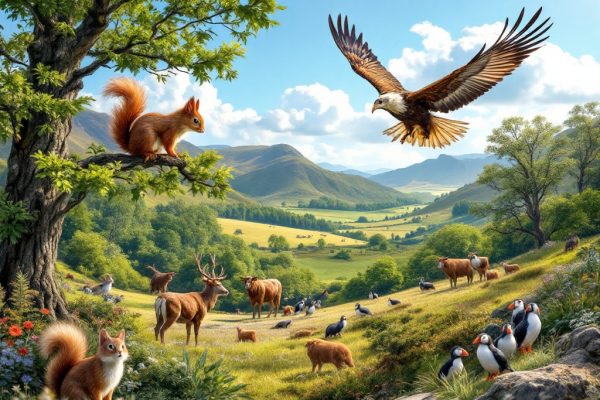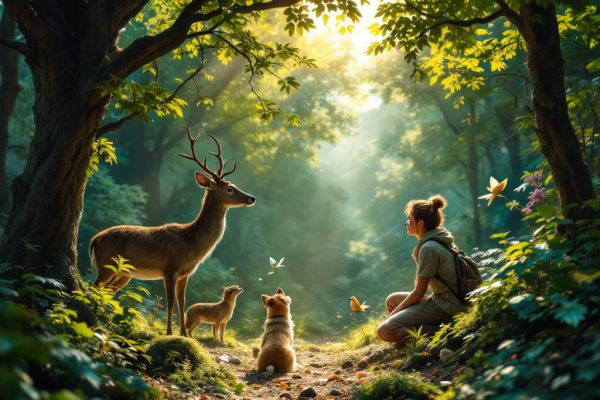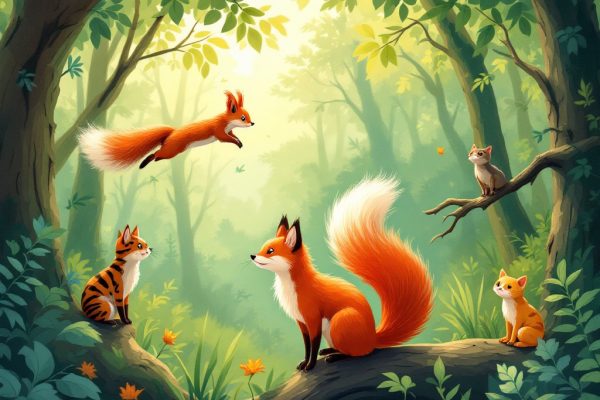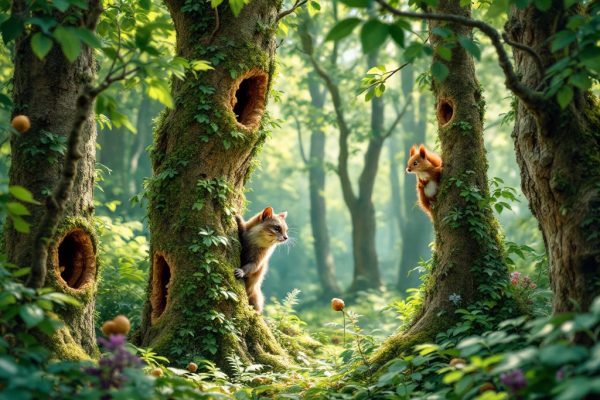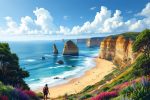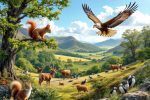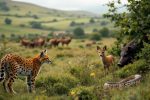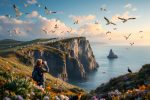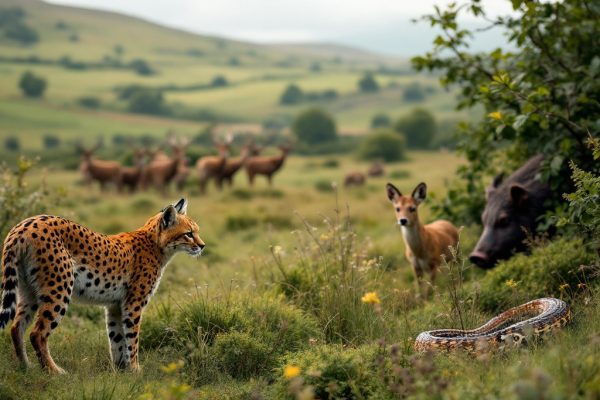How to Take Close-Up Pictures of Wild Animals in Lothian?
Ready to capture stunning wildlife photos? Lothian, from the Pentland Hills to the East Lothian coast, offers incredible opportunities for photographers of all levels. Discover prime locations like Aberlady Bay, teeming with diverse species from red squirrels and mountain hares to majestic golden eagles. Learn essential techniques, from using telephoto lenses and mastering lighting to respecting animal habitats. Explore Lothian’s biodiversity and start your wildlife photography adventure today!
Important information
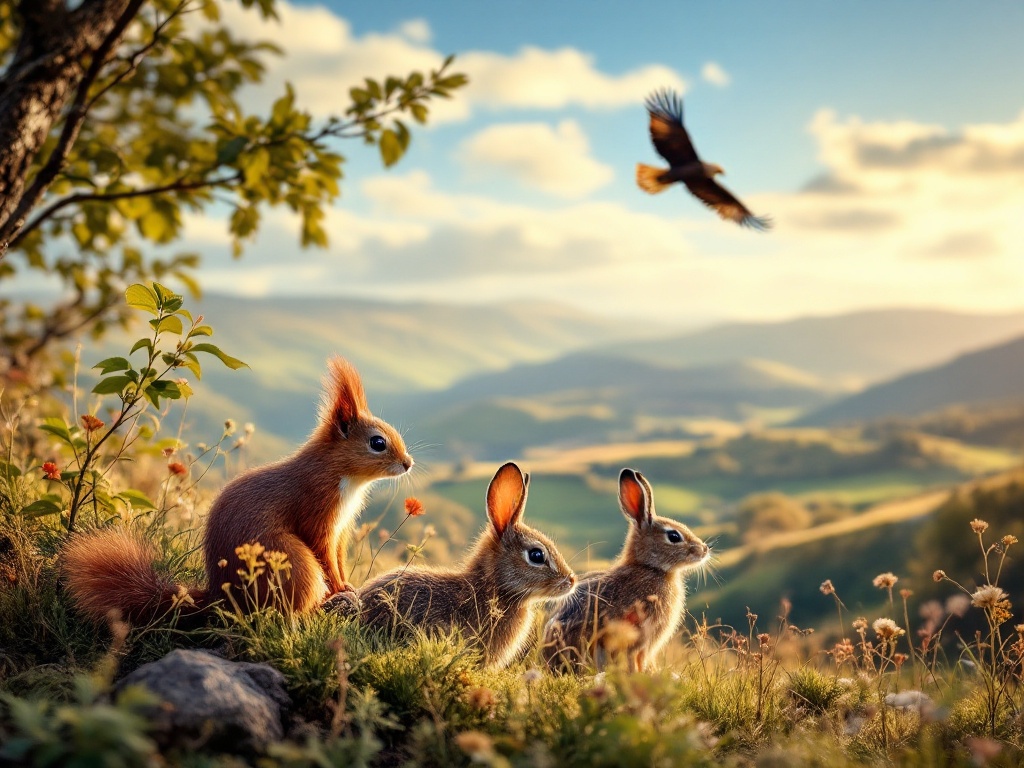
- Lothian offers diverse wildlife photography opportunities, from the Pentland Hills to the East Lothian coast, featuring species like red squirrels, mountain hares, pine martens, crested tits, and golden eagles.
- Key equipment includes a telephoto lens (200mm or greater) for capturing distant subjects, a sturdy tripod for stability, and macro lenses for detailed close-ups. Wider apertures (lower f-numbers), fast shutter speeds (1/500th of a second or faster), and appropriate ISO settings are crucial for image quality.
- Utilize natural light creatively: backlighting for silhouettes, side lighting for texture, front lighting for detail, golden hour for warm light, and overcast skies for diffused light.
- Respect wildlife by maintaining a safe distance, using long lenses for close-ups, and avoiding disturbing their natural behavior or habitats. Never approach nests, dens, or young animals.
- Patience and preparation are essential. Research animal behavior and preferred locations, use camouflage clothing, and consider hides or feeding stations for better opportunities.
Introduction to Wildlife Photography in Lothian
Lothian presents incredible opportunities for wildlife photographers, from the rugged Pentland Hills to the scenic East Lothian coast. Nature reserves like Aberlady Bay provide exceptional glimpses of animals in their natural habitats, allowing you to capture truly wild moments. Parks and woodlands teem with smaller creatures, including insects and small mammals. The Pentland Hills are home to deer and diverse bird species. The East Lothian coastline is a haven for seabird enthusiasts and offers glimpses of marine wildlife. Explore Lothian’s rich biodiversity and capture stunning images of its varied inhabitants.
Wildlife Photography Hotspots in Lothian
- Pentland Hills: Capture stunning images of deer and diverse bird species.
- East Lothian Coast: A haven for seabird enthusiasts, offering glimpses of marine wildlife.
- Aberlady Bay Nature Reserve: Observe animals in their natural habitats and capture truly wild moments.
- Parks and Woodlands: Discover and photograph insects and small mammals.
Explore Lothian’s Biodiversity
Lothian offers a rich tapestry of wildlife, waiting to be discovered. From the rugged hills to the scenic coastline, there’s a photographic opportunity around every corner. Capture the beauty and diversity of Lothian’s inhabitants, from majestic deer to tiny insects.
Wildlife in Lothian: Key Species to Photograph
Lothian offers incredible opportunities for wildlife photographers. Capture breathtaking shots of red squirrels, mountain hares, and the elusive pine marten. Red squirrels thrive in mixed and coniferous forests. Mountain hares, experts in camouflage, inhabit the uplands, their coats changing with the seasons. Pine martens seek the shelter of forests and woodlands.Lothian’s birdlife is equally captivating. Photograph the delightful crested tit, easily recognized by its distinctive crest, a common sight in pine forests. Watch for golden eagles soaring majestically over the open moorlands and mountains. Lothian is truly a photographer’s dream.
Red Squirrels
Photographing red squirrels is challenging due to their speed and elusiveness. However, the payoff is the potential for breathtaking shots. Patience and an understanding of their behavior are essential for capturing these remarkable images.
Mountain Hares
Mountain hares are true masters of disguise, their fur changing with the seasons. In summer, their grayish-brown coat blends seamlessly with the foliage. Come winter, they transform into brilliant white figures against the snowy landscape. This natural camouflage makes them a stunning photographic subject year-round. These elusive creatures are most active at dawn and dusk, preferring the open expanses of moorland and mountains. Understanding their habitat is crucial for capturing remarkable images. Researching their favored haunts, such as those in Lothian, significantly increases your chances of a sighting. Patience is key to observing these fascinating animals in their natural environment.
Pine Martens
Pine martens are elusive creatures of the night and can be difficult to spot, but using wildlife hides and feeding stations significantly increases your chances of seeing them. These provide a safe vantage point for observation.
Crested Tits
Photographing the energetic crested tit poses a challenge due to their quick movements. However, using a telephoto lens allows for detailed close-ups from a distance, respecting the birds’ space and keeping them undisturbed.
Golden Eagles
Golden eagles, with their impressive wingspan and incredibly powerful talons, are magnificent birds of prey soaring through Lothian’s skies. Photographers, equipped with long telephoto lenses, work tirelessly to capture these majestic birds either in flight or perched high on vantage points. It’s a challenging, yet rewarding endeavor.
Essential Equipment for Wildlife Photography
Telephoto lenses are essential for wildlife photography, allowing you to maintain a safe distance from animals while capturing stunning close-up shots.
A sturdy tripod is indispensable for minimizing camera shake, which is particularly important when using heavier telephoto lenses.
Using wider apertures, achieved with lower f-numbers, creates a blurred background (bokeh) that isolates and emphasizes your subject.
Macro lenses excel at revealing intricate details, such as the delicate veins of a flower or the compound eyes of an insect.
Fast shutter speeds are crucial for freezing motion and ensuring sharp images of active creatures.
High ISO settings become invaluable in low-light conditions, allowing you to capture images without compromising image quality.
Telephoto and Long Lenses
Telephoto lenses, starting at 200mm, are ideal for wildlife photography, allowing photographers to maintain a safe distance from animals while capturing natural behaviors. A tripod or monopod is essential for stability with these heavier lenses, minimizing blur from camera shake, especially in low light or when using slower shutter speeds. Even in good light, the added support helps when tracking moving animals, and reduces fatigue during long shoots. A monopod, for example, offers the flexibility to quickly adjust to the animal’s movements.
Camera and Macro Lenses
Macro Lenses
Macro lenses excel at capturing extreme close-ups, magnifying small subjects. They reveal intricate details often unseen by the naked eye, such as the texture of fur and feathers, the delicate structure of a plant, or the complex design of an insect.
A tripod is recommended to maintain stability and achieve sharp focus in close-up photography.
Telephoto Lenses
Telephoto lenses, especially those 200mm or longer, are best for photographing distant subjects, particularly larger animals in wildlife photography. They allow you to capture subjects from afar without disturbing them.
A tripod is recommended to minimize camera shake, especially at longer focal lengths.
Important Camera Settings
To capture sharp action photos, use a fast shutter speed, like 1/500th of a second or faster. This freezes motion. For a blurred background, choose a wider aperture such as f/5.6 or lower, creating a shallow depth of field. In low light, a higher ISO setting helps, but watch for increased noise at very high ISO values.
Lighting Techniques
Backlighting produces dramatic silhouettes, outlining subjects with striking emphasis.
Frontlighting offers even illumination, perfectly capturing details and vibrant colors.
The golden hour of sunrise and sunset bathes subjects in warm, directional light ideal for wildlife photography.
Sidelighting reveals depth and texture, accentuating an animal’s form.
The soft, diffused light of a cloudy day minimizes shadows, creating uniform lighting.
Reflectors can be strategically employed to fill shadows and highlight specific areas, enhancing the final image.
Photography Techniques for Capturing Close-Up Shots
Capturing breathtaking wildlife photos hinges on impeccable timing. By observing animal behavior and anticipating their actions, you’ll be primed for the perfect shot. While early morning and late afternoon often offer ideal lighting, stay receptive to opportunities throughout the day.
Exploring Unique Perspectives
Experiment with different perspectives and compositions to add intrigue to your wildlife photos. Crouching low provides a ground-level view, offering a fresh perspective on your subject. Consider the smaller details and how depth of field can enhance your image.
A shallow depth of field, achieved with a wide aperture (low f-stop number), isolates the subject by blurring the background. Focusing on the animal’s eyes creates a truly captivating portrait.
Utilizing Natural Light
Natural light can be used creatively to enhance your wildlife photography. Backlighting or side lighting adds a dramatic touch, creating striking silhouettes or highlighting textures. The golden hours of sunrise and sunset bathe your subject in warm, soft light, offering magical photographic moments.
Timing Your Shots
Wildlife photography relies on perfect timing and a deep understanding of animal behavior. Consider the light: the golden hour bathes your subject in a warm glow, while midday sun can create harsh shadows. Anticipating action, such as a bird taking flight, results in more dramatic shots. Knowing animal habits and practicing patience significantly increases your chances of capturing stunning images.
Finding Unique Angles and Perspectives
To emphasize an animal’s power, shoot from a low angle, making it appear larger than life.
Conversely, a high angle effectively showcases the animal within its environment.
Experiment with a worm’s-eye view by positioning yourself low to the ground, or find an elevated position for a bird’s-eye perspective.
Moving around your subject will reveal hidden details and create more dynamic compositions.
Explore different angles to find the perfect shot—it can dramatically transform your image.
Focusing on Details and Depth of Field
Macro lenses create a shallow depth of field, making precise focusing crucial for highlighting fine details. This is particularly important in close-up wildlife photography, where capturing intricate textures and features is key. Precise focusing ensures the subject’s key details remain sharp, while the background blurs, drawing the viewer’s attention to the intended point of focus. This technique isolates the subject, separating it from the environment and emphasizing its unique qualities. Whether it’s the delicate veins of a leaf or the compound eyes of an insect, accurate focus brings these details to life, transforming an ordinary close-up into a captivating image.
Using Natural Light Creatively
Natural light is crucial for capturing stunning wildlife photos. Consider these lighting conditions:
Backlighting creates striking silhouettes.
Side lighting reveals texture and depth.
Front lighting illuminates fine details.
Overcast skies provide soft, diffused light ideal for even exposure.
The golden hour (sunrise and sunset) bathes subjects in a warm, magical glow.
The blue hour (after sunset or before sunrise) offers cool, serene tones.
By observing light’s interaction with your subject and considering the surrounding environment, you can elevate your wildlife photography.
Practical Tips for Successful Wildlife Photography
Wildlife photography success relies on patience and preparation. Research your target species thoroughly, understanding their habits and preferred locations is essential. Pack accordingly, ensuring your gear includes a telephoto lens, a sturdy tripod, and appropriate clothing for the expected weather.To capture authentic animal behavior, blend into your surroundings. Camouflage or neutral-colored clothing, combined with minimal noise and movement, will keep you hidden and prevent disturbing your subjects.
Tips for Wildlife Photography
Hides and feeding stations offer a controlled environment, often attracting various species and increasing your chances of a memorable shot.
Consider the Timing
Early mornings and late evenings typically provide the best lighting and increased animal activity.
Patience and Preparation
Patience is essential for wildlife photography, it requires time and planning. Careful preparation increases your chances of capturing breathtaking images.
Blending into the Environment
To avoid disturbing wildlife and capture natural behavior, photographers often wear muted clothing made from quiet fabrics. This allows them to blend seamlessly into the environment and remain undetected.
Utilizing Wildlife Hides and Feeding Stations
Wildlife photography thrives with hides and feeding stations. These tools offer close-up encounters without causing disturbance, attracting animals and creating predictable photo opportunities. Concealed within a hide, photographers can increase their chances of capturing authentic behaviors, resulting in superior images. Imagine a deer drinking peacefully from a pond, or birds feeding just a few feet away – all within your camera’s reach.
Respect and Safety in Wildlife Photography
Understand Animal Behavior
Observing animals helps anticipate their actions and capture natural shots without disturbance. Learning their routines and communication cues allows you to predict movements and avoid startling them. Research the species you plan to photograph to understand their habits and sensitivities.
Maintain a Safe Distance
Prioritize your safety and the animals’ well-being by keeping a safe distance. Use long telephoto lenses for close-ups without encroaching on their space. Respect their territory by avoiding sudden movements and maintaining a non-threatening presence. Never approach nests, dens, or young, as this can provoke protective behavior.
Practice Ethical Wildlife Photography
Prioritize the animals’ welfare and avoid baiting or manipulating them for photos. Refrain from disrupting their natural behaviors and habitats. Adhere to local guidelines, minimize your impact, and leave no trace, ensuring the environment remains undisturbed.
Understanding Wildlife Behavior
Respect is paramount in wildlife photography. Observing from a distance helps anticipate animal behavior and plan shots accordingly. Move slowly and quietly, avoiding sudden movements. A long lens allows close-ups while maintaining a safe distance. Recognizing animal stress signals, like agitation or fleeing, is crucial. Retreat immediately if these occur to minimize disturbance. Respectful photography protects animals and future opportunities.
Observe from a distance. This helps anticipate animal behavior and plan shots accordingly.
Move slowly and quietly. Avoid sudden movements that might startle the animals.
Use a long lens. This allows for close-ups while maintaining a safe and respectful distance.
Recognize animal stress signals. These include agitated behavior or fleeing.
Retreat if animals show stress. This minimizes disturbance and preserves future photographic opportunities.
Maintaining a Safe Distance
Maintain a safe distance. This protects both you and the animals, allowing you to observe their natural behavior undisturbed.
Move slowly and quietly. Avoid any sudden movements that might startle them.
Respect wildlife regulations. Prioritize the animals’ well-being.
Use a long lens. This helps capture stunning photos from afar without encroaching on their space.
Ethical Considerations and Respect for Wildlife
Prioritize animal welfare above all else, especially over getting the perfect shot. If your presence seems to distress an animal, retreat slowly and give it space.
Respect local wildlife regulations and ethical guidelines. This includes respecting animal habitats and avoiding disturbing nests or dens.
Never interrupt their natural behaviors.
Maintain a safe distance and utilize a long lens for close-ups without encroaching.
Move slowly and quietly, avoiding sudden movements or loud noises. This demonstrates respect for the animals and their environment.

